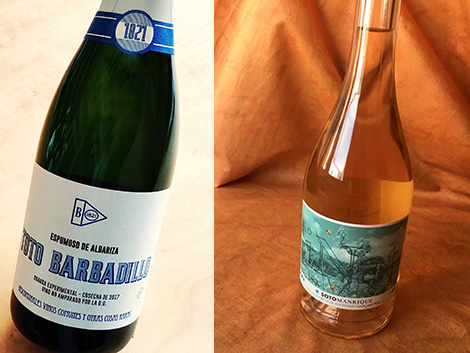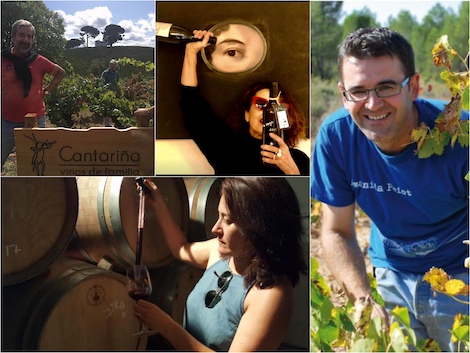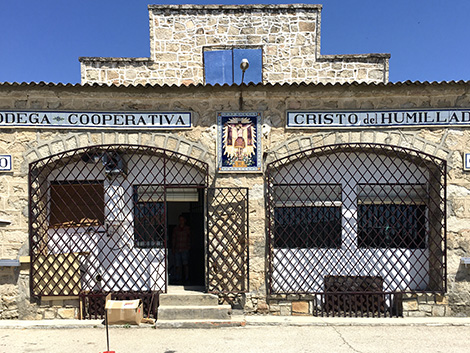15 Spanish wines to mark the end of the lockdown

We are gradually recovering many of the daily activities disrupted by the coronavirus. Long walks, the pleasure of enjoying a glass of wine outdoors and meetings with friends and family are back in our lives. And we look forward be able to travel freely again. We can’t wait to start visiting vineyards!
While we rekindle our lost pleasures, the focus is likely to be on the activity
itself, particularly when it comes to enjoying the company of our very much missed relatives and friends, rather than on the wine we have chosen for the occasion. As summer arrives and temperatures start to rise, we recommend 15 affordable, easy to drink wines to mark the return to the so called “new normal”.
iNat Ancestral Sparkling, Soto Manrique (no geographic indication)
More and more producers in Spain are jumping onto the pet-nat bandwagon, which ranks very high among our favourite summer choices. We love these uncomplicated, often sulfite-free bubblies such as the recently released iNat by Soto Manrique. Grapes are sourced from old vine Garnacha grown at over 800 metres above sea level in Cebreros, at the very heart of the Gredos mountains in Central Spain. Lovely pale pinkish colour. A clean, neat nose with red berries and creamy aromas (strawberries and raspberry cake) precedes a light, savoury palate with pleasant bitterness on the finish. Genuine glou-glou style. 3,000 bottles have been produced.
Buy this wine for €15 at Vinoteca Tierra.
Toto Barbadillo Brut Nature 2017 (no geographic indication)
One of the leading and long-established wineries in the Sherry Triangle -next year it will celebrate its 200th anniversary- Barbadillo pays tribute to Antonio "Toto" Barbadillo with this sparkling wine. An innovative and visionary man, he experimented in the 1970s with vinifications using the traditional method. Luckily, Barbadillo kept bottles that inspired winemaker Montse Molina and Armando Guerra to create this wine for "experimental ageing and produced outside the scope of the DO", as the retro-looking label states.
Made from Palomino and Chardonnay planted in albariza soils in Gibalgín and Santa Lucía, two inland vineyards, Toto Barbadillo is aged for 20 months and undergoes double fermentation in the bottle. Fine bubbles with ripe fruit and citrus notes, it is fresh and very pleasant for an aperitif or to drink with summer meals that will transport you, albeit only on the palate, to Sanlúcar's Barrio Alto. 2,000 bottles (75cl and magnum).
Find this wine for €12 on the winery's online store.
Camino de la Frontera Blanco 2018 (no geographic indication)
Laura Lorenzo is one of the most talented and creative wine producers in northwest Spain. In addition to Daterra Viticultores, her personal project in the Bibei Valley, curiosity drove her to Arribes del Duero, an area close to the Portuguese border with a long but unsung and neglected wine tradition. There she set up Sinerxia, a project in partnership with local grower Ángel Mayor, whose grapes are the basis of her trio of wines Camino de la Frontera. The white wine, made from Malvasia, Verdejo and Puesta en Cruz, comes from vineyards on granite soils in Fermoselle (Zamora). Macerated with the skins for 10 days and fermented and aged in chestnut barrels for 11 months, it is an honest, juicy white, with good fruit and perfect to accompany light meals. Only 857 bottles were filled.
Find this wine for €16.90 in Coalla.
Tantaka 2018 White, Juanjo Tellaetxe (Arabako Txakolina)
Priest and winegrower Juanjo Tellaetxe is not new to wine. In fact, he was one of the founding partners of Uno, one of the leading txakoli producers in Álava, an inland region in the Basque Country. Now he is flying solo on a mission: to make wine in Artomaña, his village, while recovering the wine growing traditions that were lost in the Arrastaria Valley in the second half of the 19th century. Behind a charming label featuring primitive ancestors, we find a single vineyard Hondarrabi Zuri white wine. Grapes are planted on alluvial soils at an elevation of 330 metres. After five months on lees in stainless steel tanks, here comes a cheerful, scented, fruit-driven txakoli with vibrant acidity and pleasant sweetness to balance the ensemble.
Find this wine for €12.75 at Montenegro Vinos online wine store.
Badiola Las Parcelas Blanco 2018, Bodegas Badiola (Rioja)
Badiola is the name of the project launched by Peninsula Viticultores in partnership with Basque entrepreneur Gorka Izagirre. Izagirre is also behind the eponymous txakoli as well as the culinary projects of his nephew Eneko Atxa including Azurmendi, his three Michelin starred restaurant near Bilbao. The winery, located in Villabuena de Álava, sources its grapes from this village and others nearby in Rioja Alavesa. Las Parcelas tries to capture the spirit of traditional Viura, a variety that used to be planted in the upper part of the vineyards where there’s usually a higher limestone content. The fact that one third of the wine is fermented in oak barrels adds extra complexity (aniseed and creamy notes over a citrus background). This is a fresh, tasty, zesty citrus white that invites to pour a second glass.
Find this wine for €14.25 at Doowine.
Descregut Xarel.lo Vermell 2017 Blanco (Penedès)
Can Descregut is a family winery which pioneered in 2006 the production of wine with Xarel.lo Vermell, a mutation of Xarel.lo with pinkish grapes and thicker skin, a longer vegetative cycle and a little more acidity which was practically extinct in the Penedès region near Barcelona. The vines grown by Arantxa de Cara and Marc Milà are over 50 years old and are worked organically using biodynamic principles. Seeking greater aromatic complexity, they harvest the Vermell at its peak of ripeness and macerate the grapes with their skins for 24 hours, resulting in a wine with a deep colour. Aged in stainless steel tanks with its fine lees for nine months and batonnage every two months, the wine displays delicate white fruit and citrus aromas, good balance and acidity and volume on the palate.
Find this wine for €13 at Cal Feru.
Dulas 2018, Bodegas Lagar de la Salud (Montilla-Moriles)
Although by no means a new winery -Lagar de la Salud was founded in 1882- Miguel Puig and winemaker Fátima Ceballos have managed to bring a breath of fresh air and innovative winemaking to this estate surrounded by vineyards and olive groves on the outskirts of Montilla. Perhaps because of their experience in Languedoc and Bordeaux, among other wine regions, they only produce still reds and whites like this young Dulas (Salud, in reverse), whose liquid content and attractive presentation in a Burgundy bottle are likely to overturn many preconceived opinions about this area, best known for its fortified wines. Made from destemmed Pedro Ximénez grapes, the region's main variety, the must ferments in stainless steel tanks where it rests on its lees for five months. On the nose, fresh aromas of white flowers and herbaceous notes give way to a young, juicy wine with a persistent finish. A different white at an unbeatable price. 4,000 bottles.
Find this wine for €9.25 at Andalucía en Vino.
Bozeto de Exopto 2019 Rosado, Exopto (Rioja)
Rosé wines are perfect for this time of year or whenever we just feel like enjoying a cool sip and don't want to be burdened with the tannins of a red wine. This wine, made by Bodegas Exopto in Rioja, is seamless and really pleasant to drink. It employs the technique of direct pressing which transfers very little colour, hence the pale Provence-style tone that is still fashionable. The blend of Tempranillo and Garnacha works seamlessly and results in aromas of red fruits and aniseed and a light yet tasty palate. Good value.
Find this wine for €7.90 at Wine is Social.
Ariyanas Rosado Romé 2018, Bodegas Bentomiz (Sierras de Málaga)
If you are always in search of discovering new wines or tasting obscure grapes, this rosé made with the Romé variety is perfect for you. Romé is grown in the steep slopes of the Axarquía mountains in Málaga. Usually destined to household consumption, this variety stands out for its high acidity. Bentomiz carefully keeps it with its lees for eight months. Beyond the ubiquitous red fruit flavours that distinguish the rosé category, this goes goes further and adds a salty edge and some dry stone notes on the finish, possibly linked to the area’s distinctive schist soils. 4,500 bottles were produced.
Find this wine for €13.30 at Tanino Wines.
Tobía Cuvée CVC Tinto, Bodegas Tobía (Rioja)
A blend of Tempranillo and Garnacha, this red is part of the quiet comeback of the CVC category or multi-vintage blends in Rioja. Whereas some producers have revived the acronym to craft super-premium reds, Tobía has been loyal to the original definition of the style (entry-level, affordable wines) by blending vintages 2017, 2018 and 2019. The resulting wine is a fruit-driven red (blackberries and blueberries) with a herbal background and liquorice flavours on the finish. I wonder whether we will see a comeback of CVC wines as producers find themselves in need to offload their excess of stock. Let’s hope that the category is used only to produce honest, affordable wines. In the meantime, this red, free of any oak excess, is a good choice to drink on a daily basis.
Find this wine for €7.50 at the winery’s online store.
Julieta Trepat 2018 Tinto, Josep Foraster (Conca de Barberà)
Despite being unknown to many wine lovers, Trepat is a grape variety that can produce easy to drink wines. Native to Conca de Barberà in Tarragona, where it has been traditionally used to make cava and rosé wines, it is being increasingly destined to red wines. A grape variety with a long cycle, Trepat fits well in a context of climate change. Julieta is a remarkably pure expression of the variety given that it is aged for seven months in concrete egg-shaped tanks -no trace of oak here. The nose is fragrant, featuring wild berries and white pepper aromas. The palate feels light, yet shows good tension, lively acidity and some length on the finish. A superb summer red.
Find this wine for €15.95 at Drinks & Co.
Castell de Santueri 2017 Rouge, Terra da Falanis (Mallorca)
A new brand launched by the team behind Ánima Negra in Mallorca, Terra de Falanis features Mediterranean wines made with indigenous grape varieties. This red with a classic-Bordeaux presentation is the latest addition to the range. The château on the label is the impressive Felanitx cooperative during its glory days, a world away from its current dilapidated state after it was abandoned in the 1980s. It’s a fitting tribute as the grapes are sourced from a vineyard formerly destined to the cooperative. Don’t expect a structured, Bordeaux-inspired red. This is a delicious Mediterranean blend of Callet (65%), Manto Negro (15%) and Cabernet Sauvignon (20%) with restrained alcohol (13% abv) and herbal, evocative notes. It is so fresh, light and pleasant that the bottle may be gone in the blink of an eye. 20,000 bottles of pure enjoyment.
Find this wine for €14 at Vivino.
Las Margas Garnacha 2018, Bodem Bodegas (Cariñena)
Located halfway between Valdejalón and Cariñena, the Sierra de Algairén is a new quality spot for Garnacha in Aragón and has attracted leading wine producers like Fernando Mora (Frontonio) and Jorge Navascués (Mancuso). It is also the source of this affordable Garnacha made by Bodegas Bodem. The winery is part of Axial Wines group, which manages other Garnacha-related projects like Pagos del Moncayo (Campo de Borja) and La Casa de Lúculo (Navarra). Whereas the name of the wine refers to the soils where the grapes are planted, wine-making (fermentation with part of the stems and ageing in a combination of stainless steel vats, polyethylene egg-shaped containers and French oak) allows the grape variety to fully express its fruit potential (ripe strawberries, scrubland herbs). This is a medium to light bodied red with lovely texture. The heavy bottle contradicts the aerial style of the wine. A Burgundy-shaped bottle would better convey the style of this good value Garnacha.
Buy this wine for €10.95 at the winery’s online store.
Kinki 2018, Verónica Ortega (Bierzo)
How many times have we heard - especially in the hottest areas of the country - that red wines are not the most suitable wines in summer because of their concentration and tannins? Well, this strawberry-coloured red banishes once and for all that myth with its subtle, elegant and light style. Made by Verónica Ortega, one of the most respected producers in Bierzo, she co-ferments Mencía, Palomino, Doña Blanca, Godello and other varieties planted in degraded slate and clay soils at an elevation of 750m in Cobrana. The stems lend the wine that fresh, red berry quality and gentle crunchiness that is rounded off by the seven months of ageing in foudres and amphora. With 11.5% alcohol, this balanced, vibrant and seductive red is best shared with friends so that you are not tempted to finish the bottle on your own. 2,100 bottles of sheer enjoyment.
Find this wine for €22.50 at La Tintorería.
La Forcallà de Antonia 2017, Rafael Cambra (Valencia)
It was a pleasure to finally meet Rafael Cambra at the Viñateros wine tasting in London last February. A pioneer in the recovery of indigenous grape varieties in Valencia, he rarely attends wine fairs and tastings outside of his region. This wine provides a great introduction to Forcallà, a red, slightly pinkish variety which was widely grown in this area of southeastern Spain. Its distinctive hard skin lets it withstand both drought and heavy autumn downpours. Grapes are sourced from ungrafted, 55-year-old vines planted at 700 metres on sandy soils (Cambra says that these varieties benefit from soils with distinct personality). The wine is fermented partially with stems and is aged in large barrels. It is really tasty, balanced and pleasant to drink, even if 2017 was a rather warm year and the wine has a higher alcohol content than usual. In terms of price, this is a real gift for wine lovers.
Find this wine for €9.50 at Drinks & Co.

Amaya Cervera
A wine journalist with almost 30 years' experience, she is the founder of the award-winning Spanish Wine Lover website. In 2023, she won the National Gastronomy Award for Gastronomic Communication

Yolanda Ortiz de Arri
A journalist with over 25 years' experience in national and international media. WSET3, wine educator and translator
NEWSLETTER
Join our community of Spanish wine lovers






